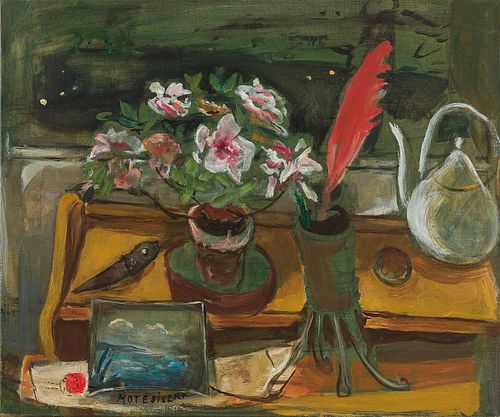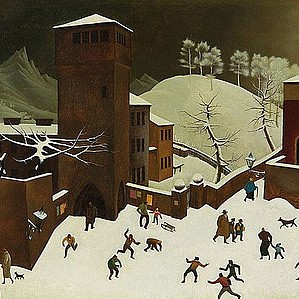MARIE-LOUISE MOTESICZKY (Vienna 1906 - 1996 London) Still Life with Azalea
Lot 59
Estimate:
EUR€5,000 - EUR€8,000
$5,434.78 - $8,695.65
Absentee vs Live bid
Two ways to bid:
- Leave a max absentee bid and the platform will bid on your behalf up to your maximum bid during the live auction.
- Bid live during the auction and your bids will be submitted real-time to the auctioneer.
Bid Increments
| Price | Bid Increment |
|---|---|
| EUR€0 | EUR€10 |
| EUR€100 | EUR€50 |
| EUR€700 | EUR€100 |
| EUR€1,000 | EUR€200 |
| EUR€3,000 | EUR€300 |
| EUR€3,600 | EUR€400 |
| EUR€4,000 | EUR€500 |
| EUR€7,000 | EUR€1,000 |
| EUR€16,000 | EUR€2,000 |
| EUR€30,000 | EUR€3,000 |
| EUR€36,000 | EUR€4,000 |
| EUR€40,000 | EUR€5,000 |
About Auction
By Widder Auctions
May 19, 2022
Set Reminder
2022-05-19 11:00:00
2022-05-19 11:00:00
America/New_York
Bidsquare
Bidsquare : Masterpieces
https://www.bidsquare.com/auctions/widder-auctions/masterpieces-9287
Masterpieces of classical modernism by Austrian and international artists coming up for auction in Vienna on May 19th Widder Auctions office@widderauktionen.com
Masterpieces of classical modernism by Austrian and international artists coming up for auction in Vienna on May 19th Widder Auctions office@widderauktionen.com
- Lot Description
MARIE-LOUISE MOTESICZKY*
(Vienna 1906 - 1996 London)
Still Life with Azalea
oil/canvas, 50,6 x 61 cm
signed Motesiczky
Provenance: Marie-Louise von Motesiczky Charitable Trust, Chiswick auctions GB, Fine Arts Widder Vienna
ESTIMATE °€ 5.000 - 8.000
Austrian painter of the 20th century. Representative of Expressionism, belongs to the forgotten generation. Her father came from the Hungarian nobility, her mother from a Jewish Viennese banking family. She was the sister of the inventor of the radio tube Robert Hermann von Lieben, her grandmother Anna von Lieben was one of the first patients of Sigmund Freund. Her brother Karl Motesiczky, psychoanalyst and resistance fighter, died in Auschwitz-Birkenau in 1943. She attended the private art school of the Czech artist Carola Machotka in Den Haar from 1922. Studied at the Städelschule in Frankfurt am Main with Max Beckmann, was her mentor and lifelong friend. Held high regard for her and saw her as a successor to Paula Modersohn-Becker. After the Anschluss, she fled to Amersham via the Netherlands and London in 1938, and lived in London from 1945. Deepened her acquaintance with Oskar Kokoschka. Became a friend and lover of Elias Canetti. Took many trips, including to Mexico, where she met her childhood friend Wolfgang Paalen shortly before his death. Received late recognition in 1985 through an exhibition at the London Goethe Institute on the initiative of Hilde Spiel, another exhibition in 1994 at the Austrian Gallery Belvedere. Created unadorned portraits of her mother, haunting self-portraits, and still lifes rich in symbolism. Influence of teacher Max Beckmann also visible in the enigmatic selection and arrangement of objects, such as azalea, quill, teapot and pocket knife.
My longing is to paint beautiful pictures, to be happy through it and to make other people happy," said Marie-Louise von Motesiczky, explaining her tireless, always very personal, artistic work wich she continued into old age. For a long time, the artist was only perceived indirectly, as standing in the shadow of great men: as a student of Max Beckmann, an acquaintance of Oskar Kokoschka or a lover of Elias Canetti. Only as a result of an extremely successful solo exhibition at the Goethe Institute in London in 1985 and a retrospective at the Austrian Gallery at Belvedere Vienna in 1994 and another at the Vienna City Museum in 2007 did she receive the place in the canon of great Austrian artists of the 20th century that she undoubtedly deserves. Her oeuvre, which consists mainly of still lifes, self-portraits and portraits and is committed to a constantly changing, increasingly lyrical, fractured expressionism, can definitely be considered autobiographical. She received a good artistic education at art schools in Vienna, The Hague, Frankfurt am Main, Paris and Berlin. From 1927 she studied at the Städelschule in Frankfurt in the master class of Max Beckmann, who remained her lifelong friend and mentor. She worked intensively in search of her own style; the hope of artistic recognition at home, however, was interrupted with the annexation of Austria in 1938. Motesiczky fled with her mother – her father had died young – first to the Netherlands and then to England, where she lived and worked until her death. The still life with azalea breathes calm, charm and love. A nice red sealed letter can be seen. It lies open and read on the cluttered bureau. The sender also sent a photo of a coastal landscape. Next to the flowerpot is a jackknife that may have served as a letter opener. The bright red feather in the middle could be a decorative object, but also a writing utensil. In her still lifes, Motesiczky likes to show her domestic surroundings; she assigns a special meaning to personal objects. It is quite possible that the letter pictured is from Motesiczky's lover, the writer Elias Canetti, who also fled to England. In July 1943, Marie-Louise von Motesiczky wrote to Elias Canetti: "Dear, dear, dearest person, first I have to tell you how wonderful it was that you came this morning. […]” This familiarity can also be felt in the present portrait. Motesiczky was a master of the portrait. Equipped with an insatiable curiosity for her social surroundings and an admirable power of observation, she created a large number of portraits that are among her most impressive works. Motesiczky explored her model sensitively and understandingly, at the same time with a sharp, unbiased view. She was always concerned with portraying the true character of the person, devoid of any idealization. Critics compared her portraits to those of Rembrandt. Elias Canetti wrote: “You must know […] that you […] have the blessed gift of preserving people as they really are. That's why I love you and that's why I need you, you give me something I don't have and I wouldn't want to live without. [...] You will become the great German portraitist.” Elias Canetti, born in 1905 in Russe, Bulgaria, into a Sephardic merchant family, spent his childhood and youth in Bulgaria, England, Zurich, Vienna and Frankfurt am Main. Only at the age of twelve did he learn the German language, which remained his true homeland. In 1938 Canetti emigrated from Vienna to England with his wife Veza. A tense love affair with Marie-Louise von Motesiczky began, while he also had his wife and other mistresses. In the 1970s Canetti moved back to Zurich, where he died in 1994. Motesiczky has portrayed Canetti several times.
PLEASE NOTE:
The purchase price consists of the highest bid plus the buyer's premium, sales tax and, if applicable, the fee of artists resale rights. In the case of normal taxation (marked ° in the catalog), a premium of 24% is added to the highest bid. The mandatory sales tax of 13% is added to the sum of the highest bid and the buyer's premium. The buyer's premium amounts to 28% in case of differential taxation. The sales tax is included in the differential taxation. - Shipping Info
-
Shipping
We will send you the invoice shortly after the auction. As soon as we have recieved the amount, the art can be picked up at Johannesgasse 9-13, 1010 Vienna. Please note that the buyer is responsible for pick-up and shipping of the lot.
Should you wish to ship your items, please contact: Mailboxes Email: oper@mbe-co.at Tel: 01 5128855
Please note that storage fees may apply, should the pieces not be picked up within 14 days after invoicing for domestic and 28 days for international transportation.
Our team will be happy to assist you with any further information at office@widderauktionen.com or at 0043 676 555 66 10.
-
- Buyer's Premium



 EUR
EUR CAD
CAD AUD
AUD GBP
GBP MXN
MXN HKD
HKD CNY
CNY MYR
MYR SEK
SEK SGD
SGD CHF
CHF THB
THB













